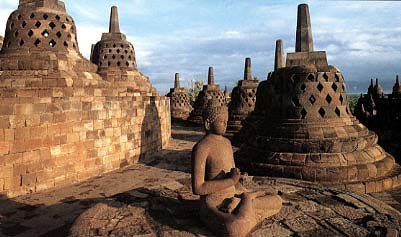| About Us | Site Map | Contact Us |
|
|
| Home | Schools & Teachings | Dharma Centers | Buddha & Bodhisattva Directory | Cosmos |
|
|
Indonesian Buddhism
|
With the spread of Buddhism to China many Chinese pilgrims sailed to India through the strait of Malacca. On their way, some stopped and temporarily stayed in Indonesia to learn more about Buddhism. In 144 AD a Chinese Buddhist saint, Fa-hsien, landed in Java island and stayed for five months. At the beginning, Theravada members were the founders. In 423 AD the Mahayana monks Ven. Gunavarman went to Java from Kashmir, from there he went to China. This is the first introduction of Mahayana to this area.
During Cailendra Dynasty (750-850 AD) the famous Buddhist temple, Borobudur (see Figure 1), was built. In 772 AD other Buddhist temple were also build. They include the Mendut, Kalasan and Pawon temples. In Indonesia most followers of Hinduism and Buddhism lived side by side in peace, blending with and borrowing from one another. Hinduism eventually took over on Java. In the 15th/I6th century, Islam influence had affected a lot. Even though Islam ostensibly erased Indian cultural traditions from Java by the 16th century, much is still visible from Buddhist-Hindu times. |
| About Us | Free Books | Site Map | Contact Us | ||
| Copyright © 1999-2020 Manjushri. All Rights Reserved. | ||

 The first Indian Buddhists arrived in Indonesia between the 1st and 2nd Centuries AD. They brought with them Buddhism in its two sects, Hinayana and Mahayana. The latter became more advanced in the 8th Century AD.
The first Indian Buddhists arrived in Indonesia between the 1st and 2nd Centuries AD. They brought with them Buddhism in its two sects, Hinayana and Mahayana. The latter became more advanced in the 8th Century AD. Around 502 AD a Buddhist Kingdom, Kanto Lim, was established by king Gautama Subhadra in South Sumatra. The king established diplomatic relations with China. On his way to India, the Chinese Buddhist pilgrim, I-tsing, visited Crivijaya in 671 AD to study the Sanskrit language. He returned 18 years later, in 689 AD. Crivijaya was then the center of Buddhist learning and had many well-known philosophy scholars like Sakyakirti, Dharmapala and Vajabudhi. The kingdom had diplomatic relations with the south Indian kingdom of Nalanda. The Crivijaya mission built a school on its premises where Indians could learn the art of molding bronze statues and broaden their knowledge of the Buddhist philosophy.
Around 502 AD a Buddhist Kingdom, Kanto Lim, was established by king Gautama Subhadra in South Sumatra. The king established diplomatic relations with China. On his way to India, the Chinese Buddhist pilgrim, I-tsing, visited Crivijaya in 671 AD to study the Sanskrit language. He returned 18 years later, in 689 AD. Crivijaya was then the center of Buddhist learning and had many well-known philosophy scholars like Sakyakirti, Dharmapala and Vajabudhi. The kingdom had diplomatic relations with the south Indian kingdom of Nalanda. The Crivijaya mission built a school on its premises where Indians could learn the art of molding bronze statues and broaden their knowledge of the Buddhist philosophy.